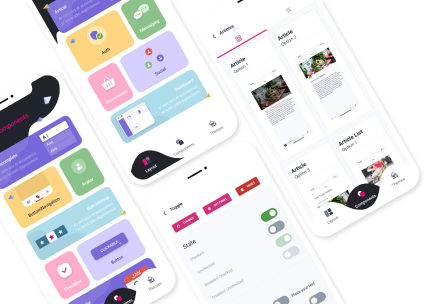Top 6 mobile app development trends in 2020
5 min readMost of us own a smartphone and we’re not afraid to use them.
About 67 percent of the global population are subscribed to mobile services, and that number is growing rapidly. We love a wireless lifestyle, and rely heavily on our mobile devices.
More than half of Australian adults don’t have a landline and 16 percent are mobile-only for internet at home. In the UK, 95 percent of people use their smartphone every day and phones are also the most-used of all devices they own.
People’s desire for convenience and immediacy means developing services and experiences to be delivered via mobiles must be a priority for businesses.
It’s no wonder, then, that the mobile app market is booming. More people are downloading, using and spending money inside native apps than ever before. Global app market revenues are expected to reach $581 billion (USD) in 2020.
Mobile app development is important for your business, but you need to understand the features and technologies that will be most in demand. An app won’t improve your customer experience or increase revenue unless people download it and use it.
Let’s explore six mobile app development trends that will drive usage in coming years.
Wearables integration
Apps that allow users to make the most of other technologies that improve their life will be more indispensable.
Wearables are rising in popularity, especially in the health, sport, wellbeing and personal safety fields. Because the tech is embedded in items you wear they’re more portable and hands-free than mobile phones.
Unlike a phone, wearables are often used to perform very specific and simple functions, and users don’t always have the skill or desire to integrate them as part of a wider IoT network. Maximising the benefits and usability of wearables is a huge opportunity for businesses looking to develop a mobile app.
Build a mobile app that cleverly augments the data and functionality of a Fitbit or smartwatch, and you’ll guarantee broader appeal.
Chatbots
Chatbots are revolutionising the way people access information and retail shopping experiences. The dependability and sophistication of virtual assistants is incredible, and advancing rapidly.
When they can get accurate answers fast, humans don’t mind interacting with robots and perceive them as innovative. So it makes sense that the development of mobile apps with embedded chatbots is something smartphone users will embrace.
For apps focused on service, helping people find the right product, or stay informed—the immediacy and human-like engagement made possible by chatbots will set your business apart.
Mobile wallets
Most of us never leave home without our smartphone, so being able to complete purchases with a swipe of your mobile is an attractive prospect. Security and bank/vendor support has improved, making the mobile wallet an increasingly preferred method of payment.
There’s already big-name mobile wallets in the market, like Google Pay and Apple Pay. While there’s room for more, in terms of future app development trends, the focus will be helping consumers make use of contactless payments.
For instance, mobile banking is now the fastest growing banking method in Australia—banks should be enhancing apps to make connecting to mobile wallets straightforward. New apps—especially retail and services—should seamlessly enable mobile wallet payment for in-app purchases and subscriptions.
Beacon technology
Beacons are pieces of hardware that are being widely used in a variety of settings to detect smart devices nearby (phones, wearables etc.) and send signals and messages to them via Wifi or Bluetooth.
A popular use is for advertising—sending retail customers personalised offers—known as geo-marketing or proximity marketing. Other applications could include tracking patients in hospitals, informing tourists at public sites, or alerting workers on large sites. Of course, people need an app on their smartphone to actually receive information from beacons.
Integrating beacon data with mobile apps has its challenges, including dealing with data transmission protocols and interpreting beacon data. Mobile apps hitting the market that leverage beacons to engage and help app users will excel.
5G network
The fifth generation of wireless network technology is poised to deliver incredible speeds and reduced latency for mobile users.
What does that mean for mobile app development? Content-heavy and bandwidth-intensive experiences can be offered without lag. For instance, apps focused on HD video, virtual and augmented reality, 3D gaming, or drawing on a massive amount of data from sensors in an Internet of Things (IoT) network.
While research by Deloitte shows that many Australians are wary of the cost associated with 5G devices (up to 84% felt the premium was too high), there will be eager early-adopters and costs will come down as the network coverage grows.
Capitalising on the capabilities of 5G via apps that allow individuals and industries to enjoy the improved performance on offer, will be a key trend in mobile app development.
Foldable devices
Not only will people soon be using 5G mobiles, their hardware may also be foldable. The buzz around foldable phones is significant—with many phone manufacturers prioritising their design and development.
This poses an issue when it comes to software development—how to achieve continuity across split screens and the functionality of different devices.
It’s also a chance to lead the market. Many of the most dowloaded apps in coming years will be those that provide a top-notch user experience on split-screens.
Building new apps, or re-imaging current apps, to work specifically on foldables is a smart move.
Build your expertise to tackle app development trends
So now that you understand the trends set to shape mobile app popularity and drive growth, the next step is to bolster your software development capabilities.Growth in the mobile app market is, in turn, driving demand for quality mobile developers. You may need to rethink your IT talent sourcing strategy to access the talent and software development expertise required to incorporate cutting-edge trends in a successful mobile app.









